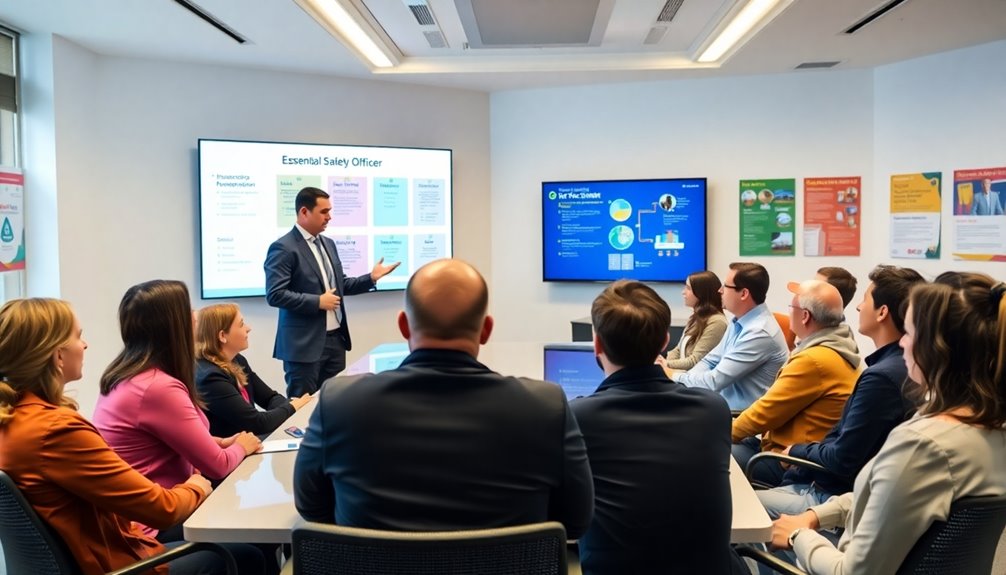When preparing for an essential safety officer interview, you'll want to focus on key questions about your qualifications, core responsibilities, and knowledge of safety protocols. Expect inquiries about your experience with safety audits and your ability to implement effective training. Interviewers may ask how you promote a safety culture and handle non-compliance. Be ready to discuss your problem-solving skills and certifications. Understanding these aspects will help you present yourself confidently. Curious to learn more about specific questions and best practices? You'll find plenty of insights as you explore further into this critical topic.
Key Takeaways
- Discuss your experience in conducting safety audits and how you identify hazards in the workplace.
- Explain your approach to developing and implementing safety policies and procedures.
- Share an example of a safety incident you investigated and how you determined its cause.
- Describe your methods for providing effective safety training to employees.
- Highlight your understanding of relevant regulations and certifications, such as OSHA standards.
Understanding the Role of Safety Officers

Safety officers play an essential role in maintaining a secure work environment, guaranteeing both compliance with regulations and the well-being of employees. In your workplace, they're the frontline defenders against hazards, working to reduce incidents and accidents across various industries.
By promoting a safety culture, you'll notice that employees become more aware and engaged in their surroundings. They guarantee adherence to local and federal regulations, providing necessary training and resources to prevent potential hazards.
Additionally, safety officers regularly conduct audits and inspections, helping to identify weaknesses in your safety protocols. Their proactive approach not only protects employees but also fosters a sense of responsibility within the team, making safety a shared priority.
Required Qualifications and Skills

Possessing the right qualifications and skills is essential for anyone aspiring to be a successful safety officer. You'll want a solid academic background in occupational safety, which lays the groundwork for your career.
Relevant work experience in safety roles is also important, as it helps you understand real-world challenges. Certifications, like those from OSHA, can enhance your credibility and demonstrate your commitment to the field.
Strong analytical and problem-solving abilities are critical for evaluating risks and implementing solutions. Additionally, excellent communication and interpersonal skills enable you to effectively educate and engage staff.
Familiarity with safety management software will also streamline your efforts in maintaining workplace safety and compliance. These qualifications together create a robust foundation for your success as a safety officer.
Core Responsibilities of Safety Officers

As a safety officer, you'll have several core responsibilities that are vital for maintaining a safe work environment. You'll conduct regular safety audits, develop policies, and investigate incidents. Providing safety training is also important to guarantee that all employees understand the protocols. Here's a quick overview of your core responsibilities:
| Responsibility | Description | Frequency |
|---|---|---|
| Safety Audits | Conduct inspections to identify hazards | Regularly scheduled |
| Policy Development | Create and implement safety procedures | As needed |
| Incident Investigation | Analyze accidents to determine causes | After each incident |
Essential Safety Audit Techniques

Conducting effective safety audits is vital for identifying potential hazards and guaranteeing compliance with regulations.
Start by familiarizing yourself with current safety protocols and guidelines relevant to your workplace. Review recent incident reports to gain insights into recurring issues.
Schedule observation sessions to assess practices firsthand, looking for any deviations from established protocols. Collect findings and prepare actionable recommendations for stakeholders to prioritize safety measures based on risk levels.
Clear communication of audit results is critical; make sure everyone understands the implications and necessary improvements.
Effective Safety Training Methods

Effective safety training methods are essential for ensuring that employees understand and adhere to safety protocols. You can employ various techniques to enhance training effectiveness, such as interactive workshops, e-learning modules, and simulation exercises. Regular safety drills help reinforce protocols and maintain awareness.
Here's a quick overview of effective training methods:
| Method | Description | Benefits |
|---|---|---|
| Interactive Workshops | Hands-on sessions with real-life scenarios | Engages employees actively |
| E-Learning | Flexible online training options | Accessible anytime, anywhere |
| Simulation Exercises | Mock scenarios for emergency preparedness | Improves response times |
| Regular Drills | Routine practice of safety protocols | Reinforces knowledge and skills |
Using these methods, you'll create a more informed and safety-conscious workforce.
Promoting Safety Culture Among Employees

Creating a strong safety culture among employees is essential for minimizing workplace incidents and fostering a proactive approach to safety. You can promote this culture by encouraging open communication about safety concerns, ensuring everyone feels comfortable reporting hazards without fear of repercussions.
Regular safety meetings can reinforce this mindset, allowing employees to share experiences and suggestions. Recognizing and rewarding safe behavior also goes a long way; it shows employees that you value their commitment to safety.
Additionally, involve employees in safety training and decision-making processes—this builds ownership and accountability. Ultimately, when you prioritize safety as a core value, you create an environment where employees actively engage in and advocate for safe practices daily.
Managing Non-Compliance Issues

Non-compliance in safety practices can lead to serious risks and hinder workplace morale. When you encounter safety violations, it's essential to respond immediately.
Start by issuing a warning to the employee, clearly explaining the importance of adhering to safety protocols. Communicate the potential consequences of their actions, both for their safety and that of their colleagues.
If non-compliance continues, develop a corrective action plan tailored to address the specific issues. This plan should include additional training and resources to reinforce compliance.
Fostering an environment of accountability and support is key. Encourage open dialogue about safety concerns, and recognize employees who demonstrate commitment to safety.
Navigating Safety Management Challenges

When it comes to steering through safety management challenges, you'll often face resistance to change from both employees and management. To overcome this, focus on building trust and engaging communication.
Clearly explain the benefits of new safety protocols and involve employees in the decision-making process. You'll also need to stay updated with evolving regulations, balancing compliance with practical implementation.
Limited budgets can strain your training programs, so prioritize essential safety measures and seek innovative, cost-effective solutions. Embrace technology and data analytics to enhance safety practices, while also addressing mental health as part of your safety culture.
With a proactive approach, you can transform challenges into opportunities for improvement and create a safer work environment for everyone.
Frequently Asked Questions
How Do You Stay Updated on Safety Regulations and Best Practices?
To stay updated on safety regulations and best practices, you regularly review industry publications, attend workshops, and participate in webinars.
You follow relevant organizations and regulatory bodies online to catch the latest updates.
Networking with other safety professionals also helps you exchange insights and experiences.
Additionally, you enroll in training courses to refresh your knowledge and gain new skills, ensuring you're always equipped to implement the most effective safety measures in your workplace.
What Motivates You to Work in Safety Management?
What motivates you to work in safety management is the desire to create a safer environment for everyone.
You thrive on helping others understand the importance of safety and preventing accidents.
The challenge of staying updated on regulations excites you, as does the opportunity to implement effective training programs.
You find fulfillment in fostering a culture of safety, knowing that your efforts directly impact employees' well-being and the overall success of the organization.
How Do You Handle Stress and Pressure in Your Role?
Handling stress in your role as a safety officer can feel like juggling flaming swords at times. You prioritize tasks, breaking them down into manageable steps to avoid feeling overwhelmed.
Regularly practicing mindfulness helps you stay calm and focused. You also lean on your team for support, fostering open communication.
Can You Describe Your Experience With Safety Management Software?
You've worked with various safety management software, streamlining reporting and training processes.
You've utilized tools that help you track incidents, conduct audits, and guarantee compliance with regulations.
By analyzing data from these platforms, you identify trends and potential hazards effectively.
You've also trained staff on using the software, making it easier for everyone to stay informed and engaged in safety practices.
Your experience guarantees a proactive approach to workplace safety.
What Innovative Safety Initiatives Have You Implemented in the Past?
You've implemented several innovative safety initiatives that transformed workplace culture.
First, you introduced interactive safety training sessions that engaged employees.
Next, you launched a safety app that streamlined reporting hazards.
Finally, you created a reward system for teams achieving safety milestones, fostering healthy competition.
Conclusion
To sum up, preparing for your safety officer interview is key to showcasing your expertise and commitment. Did you know that organizations with strong safety cultures can reduce workplace injuries by up to 60%? This statistic highlights the importance of your role in promoting safety and compliance. By understanding the core responsibilities and techniques discussed, you'll be well-equipped to impress your interviewers and demonstrate your potential as a dedicated safety leader ready to make a real impact.
Eugene brings a fresh, dynamic voice to our platform as one of our talented Writers. Specializing in research-driven content, he explores the latest findings in psychology and personal growth, translating them into actionable insights for our readers. Eugene’s work is fueled by a curiosity about what makes us tick and a desire to help others unlock their potential.










